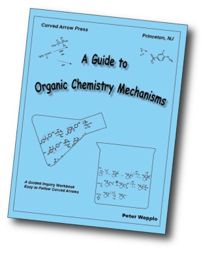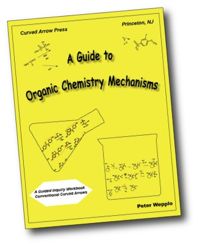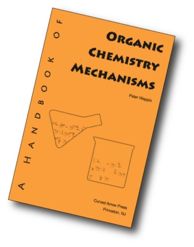A Guide to Organic Chemistry Mechanisms
This is the original book that was written
with the easy to follow curved arrows. That means
you can understand what bonds are made and broken
from the schemes themselves. (You can draw the
products without consulting your textbook.) The
rules for curved arrows are limited and exact. It
doesn’t mean one in one case and something else in
another. If a curved arrow ends between two atoms,
a bond is formed between them. If a curved arrow
ends on an atom, a bond is broken. No other uses
are made or implied.
This book uses multi-tiered example-based teaching. With this approach, problems are presented at different degrees of difficulty. Success is a required element in learning, so it is important that everyone can do the problems. In Part A, only the logic of a problem is presented so everyone do it. Then the same problem is repeated in Part B in which the problem is made incrementally more difficult by removal of pre-bonds and every other intermediate. If you understood the chemistry of Part A, you should be able to complete Part B. Finally, in Part C, you must solve the problem as written in a manner similar to your textbook.
Because I believe that our brains are pattern matching machines, patterns have value in learning. The mechanisms have been written to use and repeat patterns. Using and repeating pattern can also have a profound influence on reaction mechanisms. It is difficult to suggest a different role for a chemical solely because the electrons it reacts with are delivered by a different nucleophile.
This is the book that I used in my classes in which they were was able to make the improvements noted on the ACS organic chemistry exam.
This book uses multi-tiered example-based teaching. With this approach, problems are presented at different degrees of difficulty. Success is a required element in learning, so it is important that everyone can do the problems. In Part A, only the logic of a problem is presented so everyone do it. Then the same problem is repeated in Part B in which the problem is made incrementally more difficult by removal of pre-bonds and every other intermediate. If you understood the chemistry of Part A, you should be able to complete Part B. Finally, in Part C, you must solve the problem as written in a manner similar to your textbook.
Because I believe that our brains are pattern matching machines, patterns have value in learning. The mechanisms have been written to use and repeat patterns. Using and repeating pattern can also have a profound influence on reaction mechanisms. It is difficult to suggest a different role for a chemical solely because the electrons it reacts with are delivered by a different nucleophile.
This is the book that I used in my classes in which they were was able to make the improvements noted on the ACS organic chemistry exam.
A Guide to O Chem Mechanisms, w Conventional Curved Arrows
As you may note from the description above,
many innovations have been combined into an
encompassing guide for learning organic chemistry.
However, in doing so, one of the most readily noted
differences is that the curved arrow usage has been
changed. While pre-bonds make the reactions
understandable simply with logic to all students in
Part A, that usage is non-standard. Accordingly,
the pre-bonds are not used. I have not data to
assess the degree to which pre-bonds may help or
hinder a students understanding of chemical
reactions.
In all other aspects of the book, they are identical. The same multi-tiered examples are used in four parts. Part A lacks the curved arrows, Part B lacks every other intermediate, and Part C, is similar to textbook problems.
In all other aspects of the book, they are identical. The same multi-tiered examples are used in four parts. Part A lacks the curved arrows, Part B lacks every other intermediate, and Part C, is similar to textbook problems.
A Handbook of Organic Chemistry Mechanisms
While A Guide to Organic Chemistry
Mechanisms and A Guide to Organic
Chemistry Mechanisms, with Conventional Curved
Arrows emphasize how to learn, A Handbook
of Organic Chemistry Mechanisms is simply a
reference book. The layout and objectives of the
prior books made it awkward to introduce proximate
explanations. This book is not limited in that
manner. Thus, a clearer narrative describing many
principles and nuances are given. While I believe
your memory is improved by the concentration
required in answering the leading questions, this
book uses a narrative style and may be more easily
followed.
The objective of this book is to be a reference source. The mechanisms and products of the reactions are the same. Since students told me the mechanisms were easier to understand when written with pre-bonds, they have been retained. Because I believe that students can learn and understand better when they recognize patterns and principles, the reactions are organized by reaction mechanisms. The reactions within a chapter or on the same or next page, will be mechanistically similar. Therefore, even if you only wish to use the book as a reference, the chemistry is written so that it will be easier to detect similarities and differences in reactions.
The objective of this book is to be a reference source. The mechanisms and products of the reactions are the same. Since students told me the mechanisms were easier to understand when written with pre-bonds, they have been retained. Because I believe that students can learn and understand better when they recognize patterns and principles, the reactions are organized by reaction mechanisms. The reactions within a chapter or on the same or next page, will be mechanistically similar. Therefore, even if you only wish to use the book as a reference, the chemistry is written so that it will be easier to detect similarities and differences in reactions.


